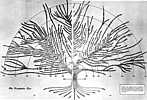Time-Lines, Problems
orWhy is a "History of Computing" project so difficult?
with comments about "Time Line of Computer History"
- It is no secret that most stoves, refrigerators, ... now use computers to control basic functions.
- You know of course that your automobile, DVD player, TV, and cell phone contain one or more computers.
- As an example, California would not renew my automobile license unless the machine's computer(s?) were reprogrammed.
- Many of our friends use computers at work, and you know about the grocery check out station.
- Wouldn't a nice, easy to read, understandable History of Computers be great? Better than apple pie ;-))
- As an example, California would not renew my automobile license unless the machine's computer(s?) were reprogrammed.
But it seems impossible to produce such a history - in less than a book shelf -
Complexity on so many levels !!
- Hardware -
- we have come from amazingly complex gears, levers, cams, punched cards, ...
- through vacuum tubes with glowing filaments, heating red cathodes, flying electrons, ...
- through generations of transistors with pure silicon intentionally "doped" with strange chemicals, that work somehow
- and now into a silicon chip smaller than your fingernail that has millions of transistors, most smaller than the cells in your body.
- and computer speeds have gone from hundreds of instructions per second to say 500,000,000 instructions per second per core.
- human interfaces, printers, punched cards, keyboards, monitors, video cards, computer music,
- memories of various sorts -
- machine interfaces, serial, parallel, SCSI, Ethernet, ...
- and we have not touched on analog computers, specialized telephone switches, specialized military, imbedded, data acquisition, ...
- Software -
- At my first computer job you could make a one card program to type out "Hello World"
- On a 1975 8K PET computer, you could teach any 10 year old kid to program in BASIC, "Hello World" in about 10 minutes
- In the 1980's, when "C" was developed, you needed an operating system,
with print format module, dynamic memory allocation, device drivers, loaders, permissions, ...
- After several days of C class and a much larger machine, a student could "Hello World"
- In the 2000's you need Linux or Windows. A mere mortal can barely install Linux, Apple has an embarrassing number of incompatible generations of software, and no one understands how Windows works, or doesn't as the case may be.
- Now, a very low percentage of "us" have a computer equiped to create a "Hello World" program.
- Applications - what an explosion, even GPS receivers,
- Does any of us understand placing a dot on a monitor, a computer animation with polygons, ...
- .
- After several days of C class and a much larger machine, a student could "Hello World"
- Computers for sale
- Back in the good olde dayze, many different manufactures, each with different lines of non-compatible computers. Lots of magazines with lots of interesting discussions.
- Then around 1965, IBM introduced a line of "do everything pretty good" computers called the 360 architecture. If you had enough memory ..., basically you could run any 360 program on any 360 computer. (well - maybe not the 360 mod 20, a different beast.) Things started to get standardized and boring.
- Now, most of us run Windows (or Linux or an Apple variant) on INTEL architecture, and who bothers with a computer oriented magazine any more? The only discussion is how many identical "cores" are on your chip and can your software make use of more than one?
- And People, a whole stadium of interesting contributors.
- And the companies, financing, failures, ... . And bench marks/speeds, and prices, sales techniques, and ...
The above is a bit of a history of stored program digital computers, but not at all satisfying.
OK - lets take a one view of the history of computers - the computers for use or sale.
Well let's make a tree attempting to trace the genealogy of which computer development begat what (approximately, mostly)
| Here is a tree that does not include early starts such as Zuse, Atanasoff, Aiken
before any of the computers most of us know about.  Squintable version Readable version, 340 K bytes
| |
| and another, less complete list,
Well before the IBM PC. page one
| page two  stitched 300KBytes |
Hmmmm - People keep using the term "Time Line" of Computer History -
- draw a line on a paper, or a line on a museum floor,
- place some (ascending?) dates on the paper or floor and
- populate the line with old computer oriented stuff/information
- Sounds simple to me - what can the problem be??
- I contend that a computer oriented history is a multidimensional web, not a line
- computer names and/or artifacts
- computer technologies, say memories, switches (relays, tubes, semiconductors), packaging, ...
- computer equipment, key punches, sorters, accounting machines, printers, displays, bank document handlers, ...
- computer companies, product lines,
- computer people
- computer speeds, storage, costs, usage, ...
- Sounds simple to me - what can the problem be??
NOW - "Your challenge, should you accept it," is to make a "time line" from the above trees, representing history
Intimidated? Well, I am !! I wouldn't touch such a project with a "ten foot pole". Yet, good people, smarter 'n me, are trying it.
- This is far beyond "engineering compromise" which I practiced for many years.
(This statement does not include "modern art", I have thrown and spun paint, and feel I am as good as any "artist". ;-))
A NOBEL PRIZE (in which category) to someone who can satisfy more than 10% of the general English speaking population??
Sincerely,